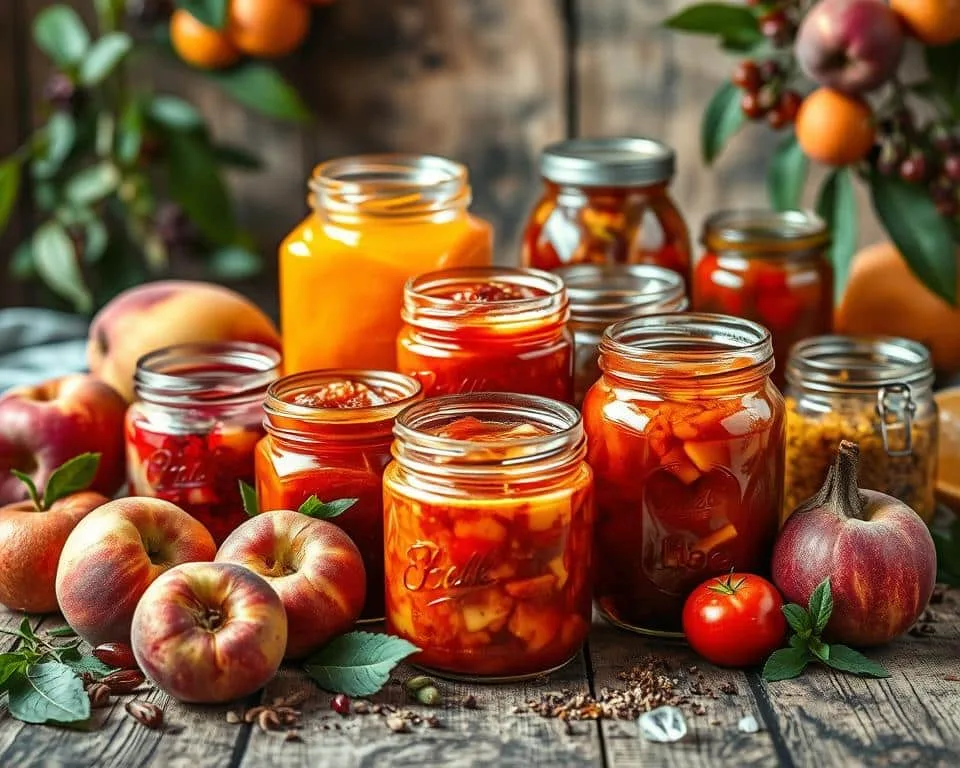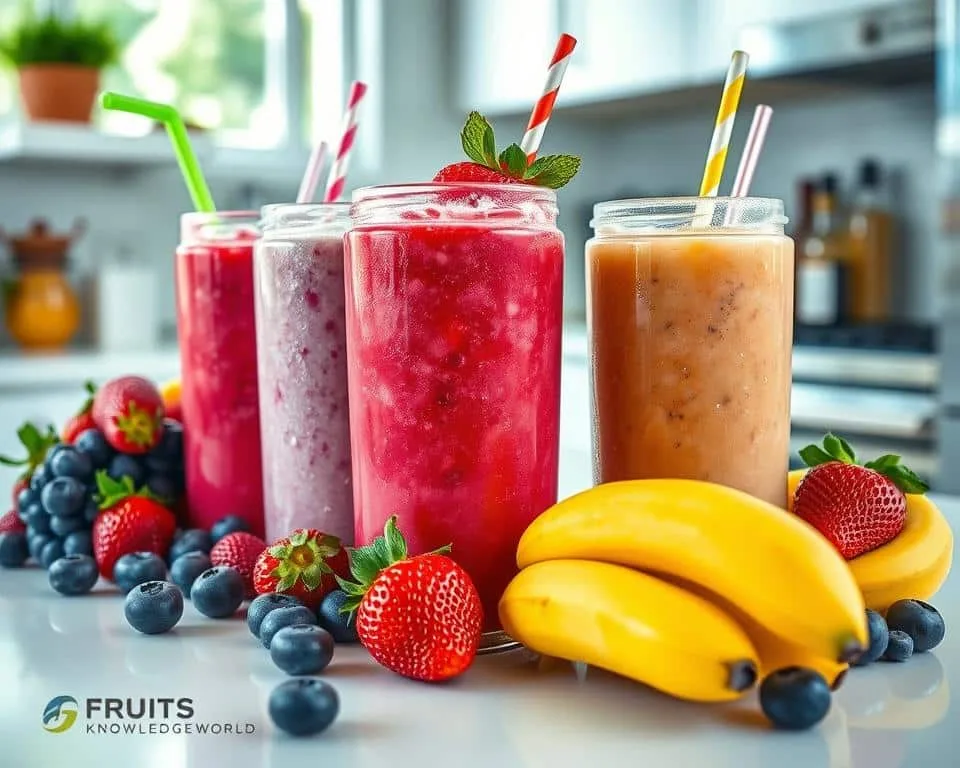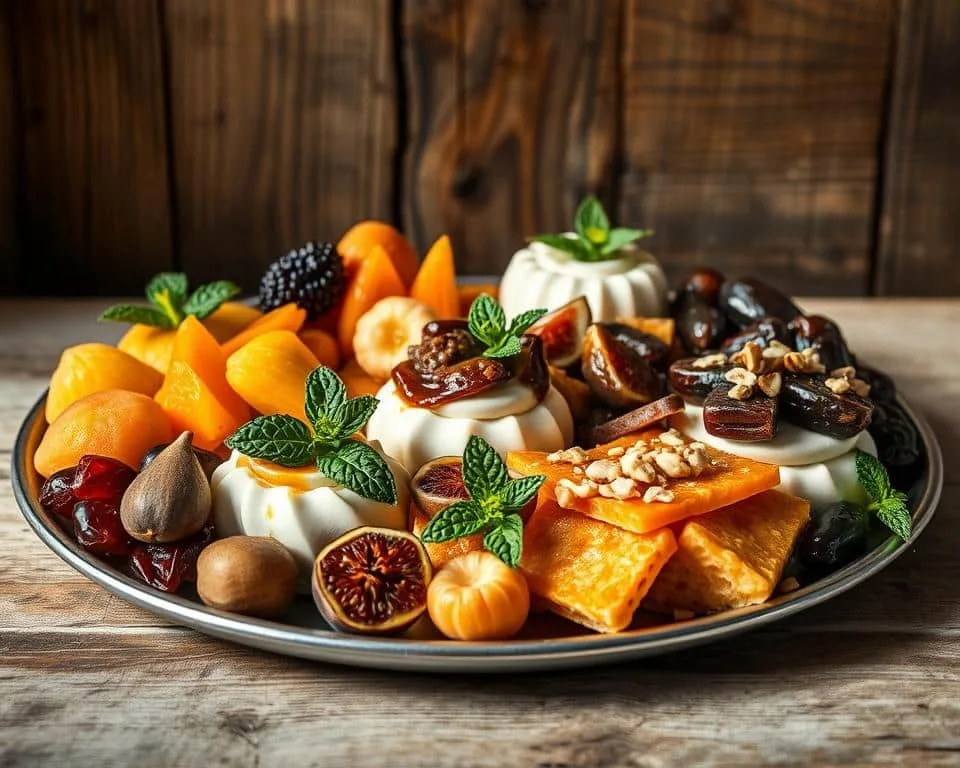Moving from making jam and marmalade to homemade chutney is exciting. The flavor of homemade sweet and tangy fruit chutney beats what you find in stores. These chutney recipes make it fun to turn local market fruits into a tasty preserve.
This preserve gets better as it sits, adding a unique homemade touch. You also get to mix different fruits for unique sweet and tangy tastes. Your chutneys will grow in flavor, becoming a special part of your pantry.
Key Takeaways
- Homemade chutney offers superior flavor compared to store-bought versions.
- Customize combinations for personalized fruit preserves.
- Transform less-than-perfect fruits into a flavorful shareable preserve.
- Chutneys mature over time, developing depth and character.
- Perfect condiment for various dishes and as a mango chutney substitution.
Introduction to Fruit Chutneys
Fruit chutneys are now a must-have in many homes. They mix sweet, tangy, and sometimes spicy tastes. This fruit chutney introduction shows how they can change dishes. These condiments add flavor and make everyday meals special.
Mango Chutney is a favorite for many. It uses mangos, ginger, garlic, chili, and vinegar. It’s great with curries, lamb, and pork. Plus, making chutneys is easy, just like homemade preserves. For example, Tomato Chutney takes 25 minutes to make and serves eight.
Chutneys differ from jams in taste and texture. They are savory or spicy, not just sweet. Also, they are smoother than relish, making them perfect for spreading or dipping. This enhances meals wonderfully.
Chutneys like Major Grey’s, Mint, and Tomato have unique tastes. Cooking them is about slow boiling fruits or veggies with spices and vinegar. This brings out their flavors. Chutneys typically have a sugar content of 25-30 Brix and 50% fruit.
Chutneys are known for their bold, spicy, and sweet taste. Schools like Walter Vogt Estudio Gastronómico teach about them. Originating in India, the English brought chutneys to the West. Now, they’re key with meats, especially roast beef.
| Chutney Type | Main Ingredients | Culinary Uses |
|---|---|---|
| Mango Chutney | Mango, ginger, garlic, chili flakes, vinegar | Curries, lamb, pork dishes |
| Tomato Chutney | Tomato, spices, vinegar | Spread, dip, roasted poultry |
| Mint Chutney | Mint, cilantro, green chili, lemon juice | Grilled meats, sandwiches |
| Peach or Pear Chutney | Peaches or pears, raisins, onions, brown sugar, vinegar | Cheeses, cured meats |
Chutneys are versatile in flavor and uses. They can be fresh or preserved. They’re perfect for enhancing meals throughout the year.
Classic Sweet and Tangy Chutney Recipe
Dive into this classic chutney recipe that mixes sweet and tangy perfectly. It’s great for making your meals exciting. Let’s start cooking!
Ingredients
Here’s everything you need for delicious homemade chutney:
- 2 Oranges
- 2 Red apples
- 1 Green apple
- 4 Kiwi fruit
- 2 Plum/aloo bukhara
- 2 Peaches
- 1 Raw Mango/Kachcha Aam
- 2 tbsp Dried Black Raisins
- 1 cup Sugar
- 1 tbsp Chili flakes/Kuti hui laal mirch
- 1 tsp Ginger/Adrak chopped
- 1 tsp Red chili powder
- 1/3 tsp Garam Masala Powder
- 2.5 tbsp Vinegar
- 2 tbsp Cooking Oil
- 1 tsp Cumin Seeds
- 1 inch Cinnamon
- 4 Green Cardamom

Instructions
Just follow these steps to make your chutney:
- Prepare the ingredients: Chop up the fruits and set them aside.
- Heat the oil: Warm the oil in a pot on medium. Then, add cumin, cinnamon, and cardamom. Wait till it smells good.
- Add ginger and fruits: Next, put in the ginger. After it smells nice, add the fruits to the pot.
- Combine dry ingredients: Throw in the sugar, chili flakes, chili powder, and garam masala. Stir so the fruits get coated well.
- Pour vinegar and mix: Add the vinegar and mix. It helps mix the sweet with the tangy taste.
- Simmer: Let it boil, then simmer on low heat. Stir now and then, for 20 minutes, until it thickens and turns brown.
- Cool and store: Let it cool after cooking. Put it in sterilized jars and close them tight. Keep the jars in a cool, dark spot to make the flavor better.
Enjoy your tasty homemade chutney with your favorite meals. Ready in just 35 minutes, it’s sure to enhance any dish.
Seasonal Fruit Chutney Variations
Exploring seasonal chutneys brings joy to your kitchen. Each season offers unique fruits for vibrant chutney variations. We’ll explore ingredients and flavors that make summer and autumn chutneys stand out.
Summer Fruits
Summer fruit chutneys are full of fresh, lively flavors. Use peaches, mangos, apricots, or cherries for indulgent treats. These chutneys often need 3 pounds (1.5 kg) of ripe fruits, like plums or peaches. They also require 1/2 cup of finely-julienned peeled ginger and thinly-sliced garlic. Add 1 1/2 cups (375ml) of vinegar, like cane or cider, and you can include 1/2 to 1 cup (75-150g) of raisins for complexity.
The spice mix has cayenne pepper, a small cinnamon stick, four whole cloves, and salt. Add grated peel from one organic orange for a twist. Cook for about 2 hours until it becomes soft like jam. Let it sit for a day before enjoying to blend the flavors well. This way, you preserve seasonal fruits in a delicious chutney.
Autumn Fruits
Autumn fruit chutneys have rich, bold flavors. Try figs, plums, or grapes for these recipes. They use 3 pounds (1.5 kg) of fruits and similar amounts of ginger, garlic, vinegar, and spices. But the choice of fruits gives autumn chutneys a distinct flavor that celebrates autumn’s harvest.
The cooking steps are like summer chutney’s but with different ingredient amounts. Choose from sweet fig to tangy plum versions. It’s all about preserving seasonal fruits in tasty chutneys.
| Ingredient | Summer Chutneys | Autumn Chutneys |
|---|---|---|
| Fruits | Peaches, Mangos, Apricots, Cherries | Figs, Plums, Grapes |
| Spices | Cinnamon, Cloves, Cayenne | Similar with seasonal adjustments |
| Cooking Time | 2 hours | 2 hours |
| Storage | Refrigerate for 2 weeks or canning method | Similar storage methods |
Embrace the changing seasons with these chutney varieties. Enjoy unique flavors from a summer mango chutney or a rich autumn fig blend. They’re a delicious way to celebrate each season.
Perfect Pairings with Fruit Chutneys
Looking to boost your meals? Fruit chutneys are great for this. They go well with cheese, cold meats, and other dishes. Their ability to transform a meal is always impressive.

- Pheasant Rosemary Pâté: Pair with Spiced Plum Chutney for a unique taste.
- Chicken Ballotine: Tamarind Chutney adds a tangy twist.
- Chicken Liver Pâté: Mango Pineapple Chutney brings sweetness and zest.
- Black Peppercorn Mousse: Cherry Tomato Chutney adds bold flavor.
Cheese and chutney are a timeless match. Try chutney on cheddar with crackers for a tasty snack. Or, add chutneys to a cheeseboard for variety.
Cold meats pair well with chutneys too. Choices like Mango Pineapple or Spiced Plum chutney enhance venison or duck. Chutney can also upgrade sandwiches or serve as a meat glaze.
Looking for new chutney ideas? Mix it with soy sauce, ginger, sweet wine, and stock for a tempura sauce. Roasting veggies with chutney adds a sweet and tangy twist.
Chutneys work great in dips. Mix them with salsa and herbs for a cheeky dip. Or, for a savory option, blend chutney with cream cheese. It’s perfect for any party.
Chutney pairings can turn a regular meal into something exciting. Whether with cheese or meats, they offer endless tasty options. Next time, try adding chutney to your dishes and get creative!
Tips for Making Fruit Chutneys
Making perfect fruit chutneys means finding the right mix of sweet and sour. It’s important to pick and mix the right ingredients carefully when making chutneys.
Balancing Sweet and Tangy
Getting the sweet-tangy balance right is key in chutney making. Begin with a mix of 2/3 fruit to 1/3 aromatic ingredients. Use fresh fruits like apples, pears, and mangoes and mix them with dried cranberries or raisins.
The type of sugar you use will change the taste. Brown, white, or turbinado sugars work well. Add depth with onion, garlic, and ginger. Spices like black pepper, curry powder, and cinnamon add layers of flavor. The right balance makes a chutney both tasty and full-bodied.
Storage and Preservation
Storing chutneys properly keeps them tasty and safe. It’s very important to sterilize jars first. Put them in an oven at 120°C for 10-15 minutes. This step helps them last longer.
Use glass jars with metal lids that don’t react with vinegar. These can be reused if they’re still good. Sugar and vinegar act as natural preservatives. This allows you to store chutneys without needing a water bath. Chutneys get better with time and can last for years in a cool, dark spot.
Conclusion
The art of making chutney is truly special and rewarding. You’ve learned how fruits like apples, pears, and cherries blend together. They make a delicious mix of sweet and sharp tastes. Making chutney is a fun way to bring out unique flavors in your meals.
Making chutney at home is better than buying it. You get to add a personal touch. From chopping fruits and onions to simmering everything in honey, it shows your dedication. You now know how to adjust recipes for any season. This way, your chutneys can be great homemade gifts.
Chutneys are not just for recipes; they can do much more. They can improve cheese plates, grilled foods, or act as tasty dips. Fine dining places also use them to add extra taste. With these skills, enjoy making chutneys and discovering new flavors.



